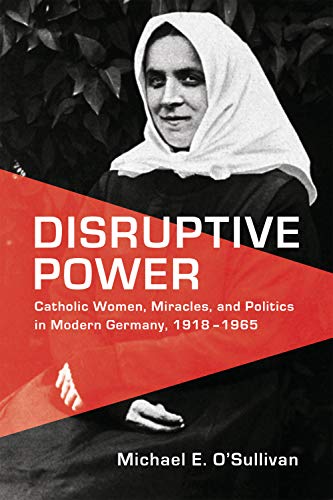
Disruptive Power: Catholic Women, Miracles, and Politics in Modern Germany, 1918-1965

Short-listed by the American Academy of Religion for the Best First Book in the History of Religions and recipient of the Waterloo Centre for German Studies Book Prize, this beautifully written monograph deserves wide readership, especially by students and scholars of Europe and sexuality. Employing the case of Catholic mystic Therese Neumann, Michael O’Sullivan challenges conventional narratives about German history to argue for “the central place of Catholic miracles to the politics of modern Germany” (17). Set against a backdrop of popular Catholic renewal, O’Sullivan’s focus on democracy, gender, and sexuality underscores the salience of religion to modern European history.
A microhistory with broad implications, Disruptive Power fascinates for its detailed account of twentieth-century Germany’s most revered stigmatic. Beginning in 1926, Neumann attracted a half-million pilgrims drawn by her visions and Christ-like wounds to the Bavarian town of Konnersreuth. Neumann’s longevity as a religious figure and the upsurge in apparitions from World War I through the Cold War highlight the durability of German popular piety across the twentieth century—all the more notable in the face of declining public worship, associational life, and male electoral support for Catholic parties. At the same time that her renown signaled ongoing religiosity, Neumann’s cult fed dechristianization by challenging male clerical control over female laity and sexuality and (with growing desire for lay access to God) by encouraging the privatization and individualization of religious ritual. This mosaic leads O’Sullivan to “suggest that German Catholicism followed a ‘braided’ and twisting rather than teleological course of secularization” (5), a phenomenon marked by uneven and incongruous patterns of religious practice and belief.
In tracing the contours of the complex evolution of twentieth-century German Catholicism, O’Sullivan rightly highlights the centrality of gender and sexuality. Determined to police “excessively feminized piety” (48), Catholic officials succeeded in effecting control over seers, either by forbidding or incorporating them into Church power structures and male-dominated rituals, including pilgrimages. Disproportionately female and rural, Catholic visionaries typically submitted to male spiritual advisors while adhering to traditional gender roles, including rigid codes of chastity and female infirmity. During her visions, for example, Neumann reinforced gendered norms by speaking in a male voice when channeling God; some stigmatics even engaged in “transgendering” during visions, signaling a desire to be male and join the priesthood. From the outset, Neumann articulated and leveraged a rising tide of Catholic sexual conservatism, even intimidating local bars into banning dancing. As her call for female modesty to contain male sexual aggression (to which she had been subjected in her younger years) reified women’s sexual purity, her support for a local teacher later convicted of sexual assault suggested little sympathy for female victims of male abuse.
But Neuman was far from “a powerless pawn of traditional patriarchs” (116). Like other Catholic visionaries, she inspired an intense following, led by supporters in the Konnersreuth Circle, that was both informed by modern media and independent of Church control. Challenging the Church’s patriarchal authority indirectly rather than directly, Neumann exercised her influence primarily in the apolitical realm of mysticism, prompting O’Sullivan to observe that “even conservative world views empowered women” (139). Indeed, the long-term effects of her provocations were manifold. To win sympathy among emotionalized pilgrims, for example, leading male adherents integrated a new “emotional piety” into their male “rationalism” (177), a shift reinforced by a more sentimental masculinity associated with Catholic DPs, expellees, refugees, and former POWs. The end result, O’Sullivan suggests, was greater spiritual volubility that undermined an elite masculinity already threatened by the pressures on Church structures.
In the same way his powerful insights into gender and sexuality enrich Church history, O’Sullivan’s exploration of Neumann’s story sheds light on the intersection of religion and politics. In the Weimar Center Party, the preexisting internecine conflicts about modernity and democracy were exacerbated when northwest German Catholics rejected Neumann as representative of an anti-modern Catholicism opposed to coalitions with liberals and socialists. Avowed detractors of Germany’s first democracy, the Konnersreuth Circle soon ran afoul of the Nazis, particularly when its leading member, anti-Nazi Fritz Gerlich, articulated early Christian Democratic principles of individual rights and interconfessionalism. In supporting the Nazis episodically while relying on Third Reich officials to resolve community disputes, the antisemitic Konnersreuth Circle well captured the complexities of Catholic relationships to the Third Reich.
Of this book’s numerous accomplishments, one of the most significant is to remind us that the Third Reich collapsed during the so-called Hour of the Church, when Germany was swept by Christian revivalism and an unprecedented “apparition boom” (209). If Neumann was the best known of postwar mystics, her cult represented just one manifestation of a phenomenon so widespread that it merited a Spiegel cover story. Visions of Mary would be channeled into Cold War propaganda, figuring into the imagery of a Western European two-front war defending the Abendland (Occident) against both Soviet “Asian hordes” and American consumerist materialism. When clerical elites sought to control the mystical movement, a “passionate revolt by rural purists against mainstream church leadership” (245) further destabilized Catholic Church institutions already weakened during the Third Reich. As O’Sullivan aptly observes, authorities’ suppression efforts, while successful in the short term, would ultimately prove the Catholic Church better at reining in its own parishioners than at adapting to societal change. That the West German social revolutions of the 1960s were influenced by Americanization makes the fact that Konnersreuth became a stage for German-American friendship all the more intriguing. Not only did Neumann enjoy U.S. Army support, but “the keen American interest in the stigmata drove Neumann’s second act as a post-war religious celebrity” (229), greatly enhancing her prominence in German society. Ironically, Neumann’s personal consumerist instincts would herald the marketing of her posthumous persona as Bavarian folklore.
By weaving a seamless tapestry of influences shaping modern German history, O’Sullivan’s nuanced analysis well demonstrates the value of close attention to the intersection of religion, gender, sexuality, and politics. If the impact of alternate models of Catholic masculinity on such Christian Democratic leaders as the Catholic troika of the 1950s—Konrad Adenauer, Hans Globke, and Heinrich Krone—remains indeterminate, the question of Catholic masculinity is nonetheless indisputably critical to West German political and religious life. And while one might probe whether Gerlich, killed on the Night of Long Knives, represented a direct link to postwar Bavarian Christian politics, especially considering the Christian Social Union’s limited interconfessionalism, it is clear that he embodied Christian Democratic ideals and their incubation under dictatorship. That the Vatican received some 45,000 letters requesting Neumann’s beatification, currently in process, testifies to the power of her legacy and the wisdom of O’Sullivan’s choice to spotlight her cult. If O’Sullivan’s work offers a blessedly compelling corrective to regrettably still common treatments of twentieth-century Germany as secular, the fact that pilgrimages, reports of apparitions, and belief remain features of contemporary German life render the disregard of religious culture in German history an unpardonable sin. In exploring and elucidating the intersections of Catholicism, politics, gender, and sexuality, O’Sullivan’s landmark study marks a key departure in German history, one that deserves every recognition.
Maria Mitchell is Professor of History at Franklin & Marshall College in Lancaster, PA, where she teaches courses on Europe since the eighteenth century, race, sexuality, and soccer. Her book, The Origins of Christian Democracy: Politics and Confession in Modern Germany, appeared in 2012 with The University of Michigan Press.
Disruptive Power: Catholic Women, Miracles, and Politics in Modern Germany, 1918-1965
By Michael E. O’Sullivan
Publisher: University of Toronto Press
Hardcover / 2018 / 344 pages
ISBN 978-1487503437
Published on October 13, 2020.




